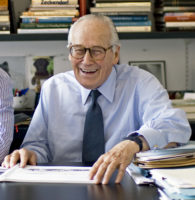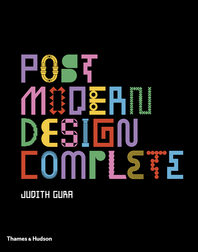Newsmaker: Robert A.M. Stern
|
In its ten-year history, the Vincent Scully Prize has been awarded to few practicing architects. The award honors individuals who have made noteworthy contributions to architectural practice—in addition to scholarship and criticism—but the majority of winners have been academics, policymakers, or patrons.
Preservationist and Robert Moses nemesis Jane Jacobs was an early winner. The Prince of Wales and the Aga Khan have also taken home the prize—as has its namesake, Yale art-history professor emeritus Vincent Scully, who has taught architectural history for more than half a century.
But this year’s winner, Robert A.M. Stern, FAIA, is very much a practitioner despite his long career in academics. Since founding Robert A.M. Stern Architects in 1969, the 69-year-old architect has designed many celebrated buildings and built a reputation for what he has described as a conservative, history-conscious sensibility and aesthetic.
His credits include the Norman Rockwell Museum (1993) in Stockbridge, Mass., the Brooklyn Law School Tower (1994) in Brooklyn, New York, and Weill Hall (2006) at the University of Michigan in Ann Arbor, Michigan. He has also worked on several controversial projects, such as master plans for New York’s 42nd Street and the Disney-developed town of Celebration, FL, a low-density community near Orlando.
At the same time, Stern taught in the graduate school of architecture at Columbia University for more than 20 years, serving as director of the historic preservation program and the Temple Hoyne Buell Center for the Study of American Architecture, before leaving for Yale in 1998, where his is currently dean of the School of Architecture. He has also found time to produce many volumes of architectural history, including co-authoring a five-part series on architecture in New York.
The National Building Museum in Washington, D.C., which administers the Scully Prize, will celebrate Stern’s win with a gala this November. In the meantime, Stern has said that he will donate the $45,000 award to Yale. Affable, with moments of mischievous wit, Stern recently spoke with me about the award and its personal significance. We also discussed a few of his current projects.
William Hanley: At this stage in your career, how do you strike a balance between your design work, academic obligations, and popular writing?
Robert A.M. Stern: I should get a Ph.D. in juggling. It’s difficult, but in my practice I devote myself to directing the design in the office, and I try to leave the administration to others. At Yale, on the contrary, I seem to do all the administration, and I don’t teach studios, which require a lot of time and a lot of energy. And the writing? What else am I going to do on Saturday? I don’t play golf.
It’s always amazing to me that if I were a writer or a literary figure or if I were a composer, these questions would not be asked in quite the same way. It goes without saying that someone who composes music also has students and also writes music criticism. Every important musician practically does. It’s only architects who talk a good game of interdisciplinarity, but in fact, they tend to ghettoize themselves.
WH: Why do you think that is?
RS: If I could answer that question, I would be more than the Scully Prize winner.
WH: Well, turning to the Scully Prize, you have known Vincent Scully for close to five decades. Does that make the award more personal?
RS: It’s very personal. I’ve known him [Scully] since I first took his course in 1960. Now I’m his dean since he still teaches at the university though less and less, but we’ve gone the full circle in these long 45 or almost 50 years.
Vince Scully is a great public intellectual for a field where there are very few. Witold Rybczynski, who won the prize a few years ago certainly falls into that category, but Vince’s influence has had tremendous impact on us all.
I think with myself—and any other architect who is really a student of Vince—we’re all still designing our projects hoping for a nod of approval from him, which he only grudgingly gives out occasionally.
WH: Does he have a favorite or least favorite project of yours?
RS: I’m sure he does. I hope he won’t share it with an audience. And I’m not going to do it now.
WH: Fair enough. Switching gears, you have also been in the news this summer for the Comcast Center. As a historian, how did you want that building to respond to the city of Philadelphia?
RS: The building itself is a major feature on the skyline. I think people are surprised by how powerful it is in its simplicity. We live in an era in which many buildings are wriggling to death. They are shaped as though they were in a terminal death rattle. This is a classical skyscraper without the rhetoric of classical language.
It’s a very simple building with a vast and column-free lobby, so it’s a grand room. I think it’s one of the grandest in proportion and airiest lobbies that have been built in a very long time. And certainly in the city of Philadelphia.
WH: Finally, you are currently working on the George W. Bush Presidential Library at Southern Methodist University in Dallas, Texas, a project that not only needs to fit into the history of its context but also has to self-consciously embody a particular historical moment—the jury on which is still very much out. How have you taken that into account in the design?
RS: Well, I’m thinking about all of those issues, but you’ll have to wait and see.



